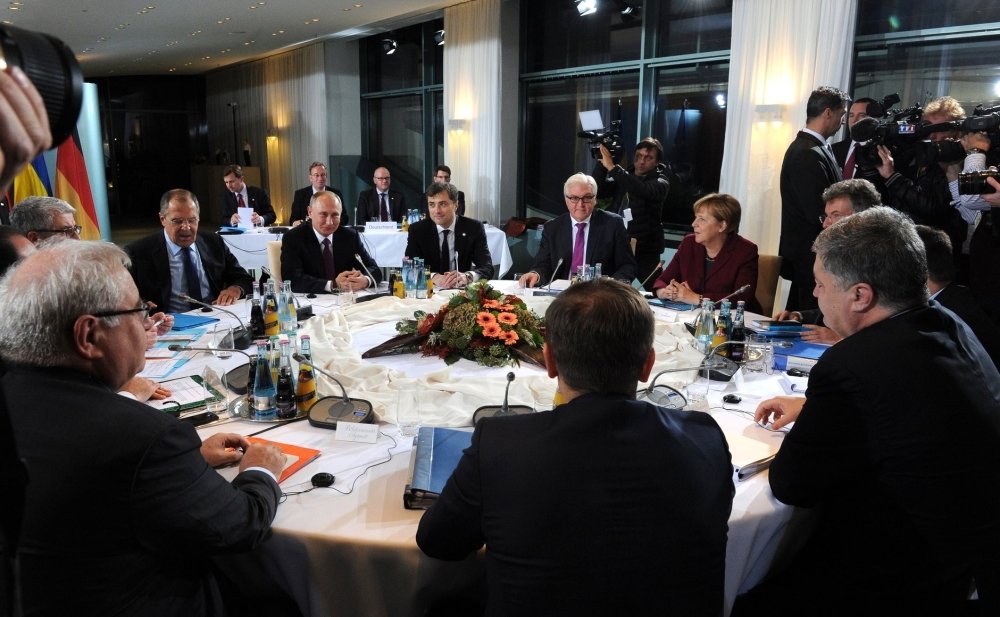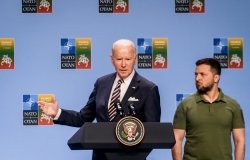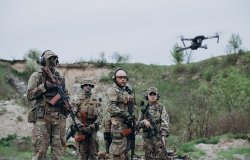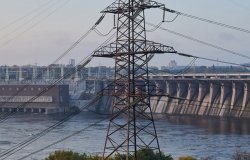
A blog of the Kennan Institute
No Result is Best Outcome for Ukraine in Renewed Normandy Format Talks

BY ILIYA KUSA
On December 9, France will host a “Normandy format” summit in Paris, the first time in more than three years that the leaders of France, Germany, Russia, and Ukraine have met to try to find a peaceful solution to the strife in eastern Ukraine. The meeting follows French president Emanuel Macron’s intervention to effect a prisoner exchange in the summer and the partial withdrawal of troops from the front lines. Further, Macron has assured Ukraine’s president Volodymyr Zelenskyy of his support at the December 9 meeting. With the passage of time, however, the geopolitical landscape around Ukraine has changed considerably, and those at the negotiations will have to take into consideration both regional and global shifts.
A highly visible shift has been the rise of right-wing national-conservative forces across Europe. The electoral results of 2017–2018 shook up the European political spectrum and challenged the traditional centrist parties. The change in political complexion has effectively contributed to a shift in European foreign policy thinking regarding Russia as many right-leaning (and Euroskeptic) politicians have started favoring the idea of a European-Russian rapprochement, naming as reasons the economic losses resulting from the sanctions against Russia, the need to reopen markets, and concern over Russia becoming even more dependent on China.
Accompanying this reorientation has been the gradual erosion of the long-standing U.S.-EU transatlantic alliance as a result of numerous fundamental disagreements between the European leadership and the Trump administration. The slowly changing world order has compelled European states to seek additional resources and markets to protect their own economies and secure themselves against foreign challenges. This has sometimes meant suppressing conflicts that directly threaten European security and borders.
Russia, for its part, had to craft a geopolitical response to the sanctions levied against it in 2014. After the country survived the first economic and financial shocks, the Kremlin unfolded a sophisticated international political campaign confected of elements of information-psychological warfare, military interventions, sanctions, political blackmail, and “flanking diplomacy”—all to coerce the West into some kind of situational truce, one that would freeze the status quo and give both sides time to pursue new approaches to managing bilateral relations. At the same time, Russia attempted to neutralize its toxic image as an aggressor state and appear as an effective global actor by intervening in different conflicts around the world, for example, by launching a military campaign in Syria; emboldening Venezuela’s strongman, Nicolas Maduro; cementing support for Libyan renegade general Khalifa Khaftar and his self-styled Libyan National Army; funneling financial, advisory, and economic aid to Central African states; and increasing its arms trade with Southeast Asia.
Ukraine has evolved since 2014 as well, though possibly not entirely on the hoped-for trajectory. Despite a promising start on reforms, the post-Maidan ruling elites proved unable to eradicate the deep-state post-Soviet system in Ukraine, now firmly entrenched through oligarchic consensus. This situation has made it almost impossible for any leader to produce the much-needed reforms without assuming grave personal and political risks.
Time is not on Ukraine’s side. For the past five years, Kyiv has fallen short in meeting its commitments to Western institutions. A slowing of reforms, inadequate gains in the fight against corruption, a seeming inability to improve the business climate or fix the abusive tax system, an underwhelming response to Russia’s invasion of the Donbas and annexation of Crimea—all these shortcomings appear to have contributed to Western fatigue with the Ukrainian project and an erosion of confidence on the part of international investors and creditors, such as the IMF. As a result, some Western political cadres are beginning to rethink the idea of working with Ukraine as an alternative to Russia.
Germany and France, the main architects of the low-profile yet groundbreaking effort to work out a rapprochement between Europe and Russia, are key to understanding the evolving nature of the EU’s relations with the Kremlin. Rather than allow Moscow to get drawn further into China’s embrace, some Western leaders have floated the idea of a cautious cooperation with Russia instead of continuing a strategy of permanent confrontation. German and French elites seem increasingly inclined to manufacture a broad compromise with Russia in a bid to ease the negative effects of the institutional and ideological crisis ongoing in Europe. To this end, it would be important to get rid of the “Ukrainian question” as expeditiously as possible.
The United States’ ultimate goal, meanwhile, appears to be limited to preserving the country’s global hegemony through its unsurpassed technological and intellectual leadership. This requires preserving current levels of growth and development, as well as maximizing profits from the old twentieth-century resource base (gas, oil, coal). This stance would explain President Trump’s consistent refusal of a “global sheriff” role for America and his threats to stop spending on allies, infrastructure, or programs he believes to be too much of a burden on the U.S. economy, instead handing these responsibilities over to coalitions of friendly regional actors. Ukraine could conceivably become part of such a coalition and receive the necessary financial, political, and military support to carry out its functions, especially if Kyiv were to outline a vision of its own role in the regional and world order, as its partners have requested. But the more Ukraine continues to be a rather passive country with no initiatives or answers, the more it retreats into a shell of historical memories and deep-rooted social problems, the more likely it is that the conflict in Ukraine’s East will lose interest for the American political establishment.
In light of the positions of the different actors as just outlined, it is unlikely that Ukraine can get results that would keep everyone in Kyiv happy. Ukrainian society is still extremely polarized over the issue of the Donbas. The Ukrainian government does not seem to have its own strategic vision of how to solve the problem, reintegrate the occupied territories, and get Russian forces out of eastern Ukraine. The Ukrainian parliament is currently embroiled in numerous internal scandals, which further complicates decision-making.
Today Ukraine is in the position of having to make what in chess is called a Zugzwang, an obligatory step that is unlikely to be propitious. It could have avoided such a drastic situation in late August after the prisoner exchange by not pushing for the Normandy format summit to such an extent that it has achieved mythic proportions in the eyes of the Ukrainian public, guaranteed to solve problems.
Three Possible Outcomes of the December 9 Summit
There are three basic scenarios for what may happen during the Paris negotiations on December 9.
Scenario 1. Under pressure from Russia and Europe, Ukraine signs a broad agreement that effectively ends hostilities and launches the process of reintegrating the Donbas through implementation of the Minsk Agreements and the “Steinmeier Formula,” signed by the parties last month. (The Steinmeier Formula proposes allowing local elections in the non-controlled territories, which many Ukrainians fear would legitimize Russia’s proxies in the region.) In this case Ukraine would be obliged to start direct talks with pro-Russian separatist leaders in the occupied East. Moreover, according to the Minsk Agreements, Ukraine would have to amend its constitution to allow “special status” for the Donbas region. Doing so would almost certainly precipitate a political crisis, with the public decrying the move and other regions potentially demanding the same semi-autonomous status. If the Donbas is returned to Ukraine without any prescribed financial mechanism for it to be restored and rebuilt, however, the result will be financial collapse for Ukraine, which lacks sufficient resources to carry out reintegration effectively.
Scenario 2. The Paris talks end without any concrete result achieved. The parties discuss the agenda, and that is the end of the negotiations, just as happened the last time, in 2016. In such a case the current status quo would continue, and without further initiatives, the process could easily deadlock.
Scenario 3. Ukraine signs a framework document that does not clearly delineate the obligations and responsibilities of the parties. This would give Kyiv more flexibility in determining its next moves. President Zelenskyy would gain some room and time to maneuver and interpret the agreement (including to the Ukrainian public), while Russia, Germany, and France could characterize the framework agreement as “progress” and move ahead with easing anti-Russian sanctions and restoring relations.
How Ukraine Could Gain
None of the three basic scenarios is likely to have a positive impact on Ukraine’s future. But the second one is the least damaging and would give Kyiv time to reinforce its position, consolidate resources, mobilize supporters, and try to put together a coherent Ukrainian vision for resolving the issue of the Donbas.
This could be done through several fundamental steps. Kyiv should shed its illusions—such as its belief that what happens in Ukraine is a top priority for Western elites and its view that the war in the Donbas is unique, even “sacred”—and take steps toward forging a robust, realistic, and purely pragmatic policy by reassessing Ukraine’s current situation, prioritizing goals with regard to the conflict in the Donbas, and revising its foreign policy, with a view to bringing it into alignment with national interests. In particular, Ukraine’s foreign policy should establish clear “red lines,” especially in regard to negotiating the future of the Donbas, that the government should not cross.
Programs aimed at reconstructing the Donbas should be revised to reflect a national reintegration strategy. It is essential to admit publicly that the war in eastern Ukraine could last for a long time and there is no quick fix for it. Finally, Ukraine should be taking control of initiatives related to the Donbas and Crimea issues by expanding the number of participants in the negotiations or the scope of the issues discussed.
These various steps provide would assure that Ukraine does not need to hurry or accelerate the Normandy format negotiations process. It is of utmost importance that Ukraine dedicate the necessary time to forging a powerful vision and a strong strategy before entering practical diplomatic engagements.
About the Author


Kennan Institute
The Kennan Institute is the premier US center for advanced research on Russia and Eurasia and the oldest and largest regional program at the Woodrow Wilson International Center for Scholars. The Kennan Institute is committed to improving American understanding of Russia, Ukraine, Central Asia, the Caucasus, and the surrounding region though research and exchange. Read more










